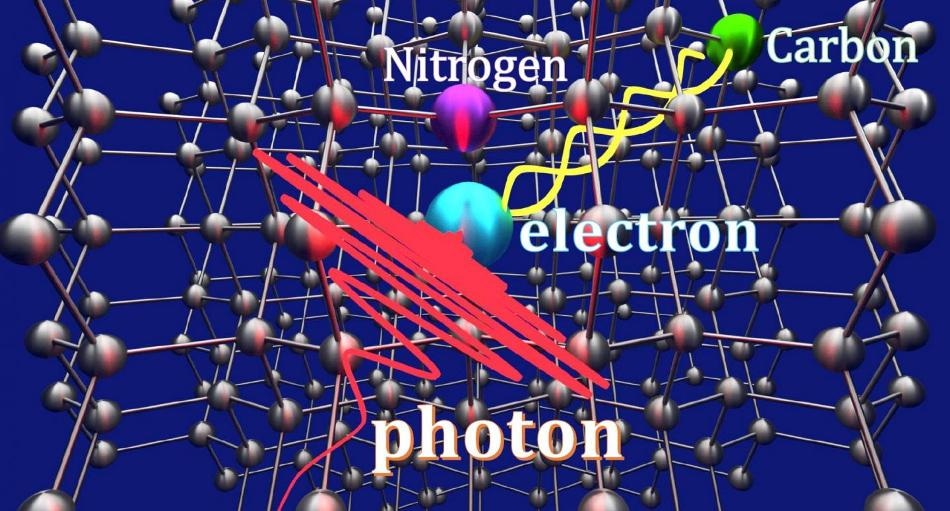Jul 1 2019
Yokohama National University scientists have achieved secure teleportation of quantum information within the bounds of a diamond. The research is highly significant for quantum information technology—the prospect of sharing and storage of sensitive information is.
 The lattice structure of diamond contains a nitrogen-vacancy center with surrounding carbons. A carbon isotope (green) is first entangled with an electron (blue) in the vacancy, which then waits for a photon (red) to absorb, resulting in quantum teleportation-based state transfer of the photon into the carbon memory. (Image credit: Yokohama National University)
The lattice structure of diamond contains a nitrogen-vacancy center with surrounding carbons. A carbon isotope (green) is first entangled with an electron (blue) in the vacancy, which then waits for a photon (red) to absorb, resulting in quantum teleportation-based state transfer of the photon into the carbon memory. (Image credit: Yokohama National University)
The study outcomes were reported in Communications Physics on June 28th, 2019.
Quantum teleportation permits the transfer of quantum information into an otherwise inaccessible space. It also permits the transfer of information into a quantum memory without revealing or destroying the stored quantum information.
Hideo Kosaka, Professor of Engineering, Yokohama National University
Kosaka is one of the authors of the study.
In this scenario, the inaccessible space included carbon atoms in diamond. A diamond is made of linked, but individually contained, carbon atoms, thereby holding the ideal components for quantum teleportation.
The nucleus of a carbon atom includes six neutrons and six protons, surrounded by six spinning electrons. The atoms form a conspicuously strong lattice when they bond into a diamond. However, diamonds could have intricate flaws due to the existence of a nitrogen atom in one of two adjacent vacancies in which there should be carbon atoms. This defect is known as a nitrogen-vacancy center.
The nucleus structure of the nitrogen atom is surrounded by carbon atoms, thereby creating what Kosaka terms a nanomagnet.
Kosaka and colleagues manipulated a carbon isotope and an electron in the vacancy by attaching a wire to the surface of a diamond, where the width of the wire is nearly a quarter of a strand of human hair. They built an oscillating magnetic field surrounding the diamond by applying a radio wave and a microwave to the wire. The microwave was shaped to develop the optimal, controlled conditions for the quantum information transfer inside the diamond.
Then, the nitrogen nanomagnet was used by Kosaka to anchor an electron. Kosaka used the radio waves and microwave to force the electron spin to entangle with a carbon nuclear spin—the angular momentum of a carbon atom’s nucleus and electron. The spin of the electrons disintegrates under a magnetic field produced by the nanomagnet, enabling it to become vulnerable to entanglement.
Upon being entangled, the physical characteristics of the two pieces are so intertwined they cannot be individually described, and a photon holding quantum information is applied and is absorbed by the electron. The absorption enables the photon’s polarization state to be transferred into the carbon, mediated by the entangled electron, exhibiting teleportation of information at the quantum level.
“The success of the photon storage in the other node establishes the entanglement between two adjacent nodes,” stated Kosaka. The process is known as quantum repeaters and can transfer individual blocks of information from one node to another, over the quantum field.
Our ultimate goal is to realize scalable quantum repeaters for long-haul quantum communications and distributed quantum computers for large-scale quantum computation and metrology.
Hideo Kosaka, Professor of Engineering, Yokohama National University